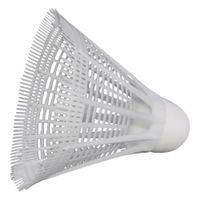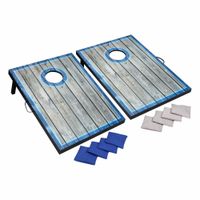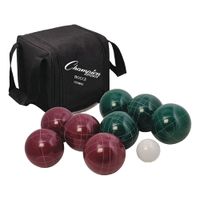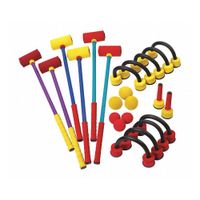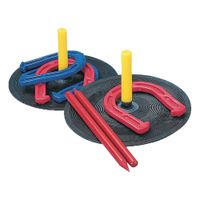Call +(254) 703 030 000 / 751 483 999 / 721 704 777
.....Read More
Frequently Asked Questions
What are the most popular lawn games?
Some of the most popular lawn games include:
1. **Cornhole**: Players take turns throwing bags filled with corn kernels or beans at a raised platform with a hole. Points are scored by landing bags on the board or in the hole.
2. **Bocce Ball**: This Italian game involves tossing larger balls to get as close as possible to a smaller target ball, known as the pallino.
3. **Croquet**: Players use mallets to hit balls through a series of hoops embedded in the grass, aiming to complete the course in the fewest strokes.
4. **Horseshoes**: Players throw horseshoes at stakes in the ground, aiming to encircle the stake or land closest to it.
5. **Lawn Darts (Jarts)**: Players throw large, weighted darts towards a target on the ground, trying to land them within a designated area.
6. **Spikeball**: A fast-paced game where players hit a small ball onto a net, similar to volleyball, with the objective of making it difficult for the opposing team to return.
7. **KanJam**: Teams take turns throwing a flying disc towards a can with a slot, aiming to score points by hitting the can or getting the disc inside.
8. **Ladder Toss**: Players throw bolas (two balls connected by a string) at a ladder structure, aiming to wrap them around the rungs for points.
9. **Giant Jenga**: An oversized version of the classic block-stacking game, where players remove blocks from a tower and stack them on top without causing it to collapse.
10. **Frisbee Golf (Disc Golf)**: Players throw a frisbee towards a series of targets, aiming to complete the course in the fewest throws.
These games are popular for their simplicity, accessibility, and ability to engage players of all ages in outdoor fun.
How do you set up a badminton court outdoors?
1. **Select Location**: Choose a flat, open area free from obstructions like trees or poles. Ensure the ground is level to prevent tripping.
2. **Measure Dimensions**: A standard badminton court is 20 feet wide and 44 feet long. Use a measuring tape to mark these dimensions on the ground.
3. **Mark Boundaries**: Use chalk, paint, or boundary tape to outline the court. Mark the sidelines, baselines, and centerline. For doubles, use the full width; for singles, mark a narrower court (17 feet wide).
4. **Net Setup**: Position the net posts at the center of the sidelines, ensuring they are 20 feet apart. The net should be 5 feet 1 inch high at the edges and 5 feet high at the center.
5. **Install Net**: Attach the net to the posts, ensuring it is taut and the top is at the correct height. Secure it firmly to prevent sagging.
6. **Service Lines**: Mark the service lines 6 feet 6 inches from the net on both sides. For doubles, add a long service line 2 feet 6 inches from the baseline.
7. **Check Surface**: Ensure the playing surface is safe, removing any debris or obstacles. Grass, concrete, or packed dirt are suitable surfaces.
8. **Equipment**: Provide rackets and shuttlecocks. Ensure they are in good condition for optimal play.
9. **Safety**: Check for any potential hazards around the court area. Ensure there is enough space around the court for players to move safely.
10. **Final Inspection**: Walk around the court to ensure all lines are visible and the net is secure. Adjust as necessary before starting play.
What equipment is needed for a croquet game?
To play a game of croquet, you will need the following equipment:
1. **Mallets**: Each player requires a mallet, which is used to strike the balls. Mallets typically have a wooden or composite handle and a cylindrical head.
2. **Balls**: Croquet is played with balls that are usually made of wood or a durable synthetic material. Standard sets include four balls, each a different color, to represent different players or teams.
3. **Wickets (Hoops)**: These are metal arches that are placed in the ground. The standard game uses six wickets, which the balls must pass through in a specific order.
4. **Stakes (Pegs)**: Two stakes are used in croquet. One is placed at the start of the course and the other at the end. Players must hit their balls against these stakes to complete the course.
5. **Croquet Court**: While not equipment per se, a flat, grassy area is essential for setting up the game. The standard court size is 100 feet by 50 feet, but it can be adjusted for smaller spaces.
6. **Boundary Markers**: Optional but useful for defining the playing area, especially in informal settings.
7. **Measuring Tape**: Useful for setting up the court and ensuring wickets are placed at the correct distances.
8. **Scorecards and Clips**: To keep track of each player's progress and score during the game.
9. **Protective Gear**: Optional items like gloves or knee pads for comfort, especially during longer games.
This equipment allows players to set up and enjoy a traditional game of croquet, whether casually in a backyard or more formally in a competitive setting.
How do you play bocce ball?
Bocce ball is played with two teams, each having one to four players. The game begins with a coin toss to decide which team throws the pallino, a small target ball, onto the playing surface. The same team then throws the first bocce ball, aiming to place it as close to the pallino as possible.
Teams alternate turns, throwing their bocce balls, trying to get closer to the pallino than the opposing team. A team continues to throw until it either runs out of bocce balls or gets one closer to the pallino than the other team. Players can use various strategies, such as knocking opponents' balls away or nudging the pallino to a more favorable position.
Once all balls are thrown, the round is scored. The team with the closest bocce ball to the pallino scores points. Only one team scores per round, earning one point for each of its balls closer to the pallino than the nearest opponent's ball. If a bocce ball touches the pallino, it is called a "kiss" and may earn additional points, depending on local rules.
The game continues with rounds until a team reaches a predetermined number of points, typically 12, 15, or 21. The playing surface can vary, but it is usually a flat, rectangular court made of sand, grass, or synthetic material. Bocce can be played casually on any open, level ground.
Players must adhere to the foul line, which they cannot cross when throwing. The game emphasizes skill, strategy, and precision, making it accessible and enjoyable for players of all ages and skill levels.
What are the rules for bean bag toss games?
Bean bag toss games, commonly known as cornhole, have specific rules:
1. **Setup**: The game is played with two boards, each 2 feet wide by 4 feet long, with a 6-inch hole centered 9 inches from the top. The boards are placed 27 feet apart from front to front. Each team has four bean bags.
2. **Teams**: The game can be played with two or four players. In singles, players stand on the same side; in doubles, teammates stand on opposite sides.
3. **Gameplay**: Players alternate tossing bean bags at the opposite board. A coin toss decides which team throws first. Players must throw from behind the front edge of their board, within the designated pitcher's box.
4. **Scoring**:
- A bag on the board scores 1 point.
- A bag through the hole scores 3 points.
- Only one team scores per round, using cancellation scoring (subtract the lower score from the higher score).
5. **Winning**: The game is typically played to 21 points. A team must win by at least 2 points, though some variations allow for an exact 21 to win.
6. **Fouls**: A foul occurs if a player steps past the foul line, throws out of turn, or a bag hits the ground before landing on the board. Foul bags are removed from play.
7. **Tiebreakers**: If both teams reach 21 in the same round, play continues until one team leads by 2 points at the end of a round.
These rules ensure fair play and consistency in the game.
How do you score in horseshoes?
In horseshoes, scoring is based on the position of the horseshoes relative to the stake after all players have thrown their shoes. The main scoring methods are as follows:
1. **Ringer**: A ringer is when a horseshoe encircles the stake. It is worth 3 points. To qualify as a ringer, the horseshoe must be able to be touched by a straight edge on both open ends without touching the stake.
2. **Closest Shoe**: If no ringers are thrown, the closest horseshoe to the stake scores 1 point. If a player has both of their horseshoes closer than the opponent's, they score 2 points.
3. **Leaners**: A leaner is a horseshoe that leans against the stake. It is typically scored as 1 point, similar to a closest shoe, unless it is also a ringer.
4. **Cancellation Scoring**: In many games, only one player or team can score per inning. If both players throw ringers, they cancel each other out, and no points are awarded for those ringers. The same applies to closest shoes; only the closest shoe that is not canceled by an opponent's shoe scores.
5. **Point Limit**: Games are usually played to a predetermined point limit, often 21 or 40 points, depending on the rules agreed upon before the game starts.
6. **Foul Line**: Players must throw from behind a designated foul line. If a player steps over the line while throwing, the throw is considered a foul, and the horseshoe does not count.
These rules can vary slightly depending on local customs or specific league regulations, but the basic principles of scoring remain consistent.
What are the best portable lawn game sets?
Some of the best portable lawn game sets include:
1. **Spikeball**: This is a dynamic, volleyball-inspired game that involves bouncing a ball off a small, round net. It's compact, easy to set up, and great for all ages.
2. **Bocce Ball**: A classic game that involves tossing balls to get as close as possible to a target ball. Sets are available in various sizes and materials, making them easy to transport.
3. **Cornhole**: This popular bean bag toss game is perfect for all ages. Portable sets often come with foldable boards and lightweight bags for easy transport.
4. **KanJam**: A frisbee-based game where players aim to hit or slot the disc into a can. The cans are lightweight and easy to carry, making it a great option for parks or beaches.
5. **Ladder Toss**: Also known as Ladder Golf, this game involves throwing bolas (two balls connected by a string) onto a ladder structure. The game is simple to set up and the components are easy to pack.
6. **Kubb**: A Swedish lawn game that combines elements of bowling and horseshoes. The wooden pieces are durable and can be packed into a small bag for portability.
7. **Giant Jenga**: An oversized version of the classic stacking game. While larger than other games, it can still be transported easily in a carrying case.
8. **Horseshoes**: A traditional game that involves throwing horseshoes at stakes. Portable sets often include lightweight plastic or rubber horseshoes for easy transport.
9. **Crossnet**: A four-square volleyball game that combines elements of both sports. The net is adjustable and the set is easy to carry.
10. **Molky**: A Finnish throwing game that involves knocking over wooden pins. The set is compact and easy to transport.
These games are popular for their ease of setup, portability, and ability to engage players of all ages.
